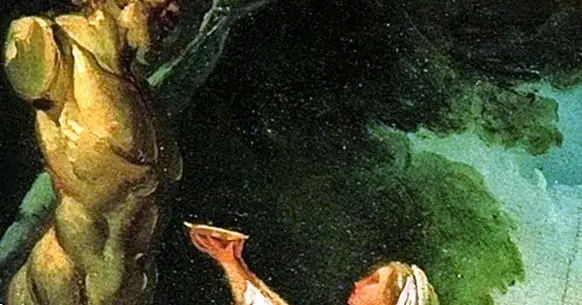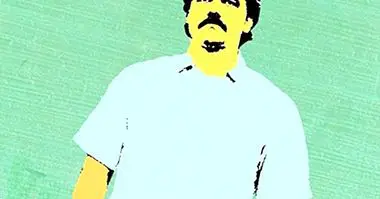Falocentrism: what it is and what it tells us about our society
The term "phallocentrism" refers to the exercise to place the phallus at the center of explanations about the psychic and sexual constitution. This exercise has been present in much of the scientific and philosophical theories of the West, it is even visible in social organization. As a concept, phallocentrism arises in the first half of the 20th century to criticize different practices and knowledge, among which are psychoanalysis, philosophy and science.
Next we will see in more detail what phallogocentrism is, where this concept comes from and what have been some of the consequences that its application has had.
- Related article: "Types of sexism: the different forms of discrimination"
Falocentrism: the phallus as the original symbol
As the term itself indicates, phallocentrism is the tendency to place the "phallus" at the center of the explanations about the subjective constitution; concept that can be used as a synonym for "penis", but that it is also used to designate a symbolic referent .
The latter comes mainly from Freudian and Lacanian psychoanalysis, but is later taken up and criticized by some currents of philosophy, as well as by feminist theories and movements, which claim a different understanding of the psyche and sexuation.
- Maybe you are interested: "The 4 main branches of Anthropology: how they are and what they investigate"
Background and development of the concept
At the end of the 18th century and the beginning of the 19th, Sigmund Freud developed a theory of psychosexual development in which he proposed that the psychic constitution of the subjects passes through the awareness of sexual difference.
This awareness brings with it two possibilities: having, or lacking, the valued object. This object is the penis, and carries with it a symbolic value that subsequently (in Lacanian psychoanalysis) it is transferred to other elements beyond the anatomical structure.
From infancy, who carries the penis enters a phase of psychic structuring based on the threat of castration (ie, to lose the phallus). On the contrary, those who do not have it go through a structuring process based mainly on this lack, which generates a constitutive envy that was called "penis envy".
Thus, the phallus was at the center of this theory of psychosexual development, arguing that the female psychic constitution occurred as a negation of the masculine, or else as a supplement to it.
The phallus, later understood as a symbolic reference; and its carrier, the male subject, they are positioned in the center of explanations about psychic and sexual development .
- Related article: "The 5 stages of psychosexual development of Sigmund Freud"
First reviews
The reactions and oppositions to the psychoanalytic theory of psychosexual development occurred both outside and within the same circle of disciples of Freud. One of them, Karen Horney, criticized in an important way the theory of penis envy , and argued that the psychic constitution of women was not necessarily traversed by such resentment.
Like Melanie Klein, Horney argued that there is a primary femininity, which is not a derivation or denial of the male psychosexual constitution.
Already in the 1920s, the psychoanalyst and later biographer of Sigmund Freud, Ernest Jones, takes up the criticisms that Klein and Horney had made penis envy theory, to argue that the psychoanalytic postulates made by men were heavily laden with "phallocentric" vision.
The latter was what formally gave origin to the concept of "phallocentrism", and since in the beginning Freudian psychoanalysis did not distinguish between the phallus and the penis, the term was exclusively used to talk about the empowerment of men .
It is up to the Lacanian psychoanalytic theory when the "phallus" ceased to correspond necessarily with the anatomical structure, and goes on to designate that which is in the center of the object of desire of each subject.
Decades later, this last one was retaken and criticized by philosophers and feminists, since it maintained the primacy of the phallus like the origin and the center of the power, the psyche and the sexuación to different scales.
Falocentrism and phallogocentrism
We have seen that the term "phallocentrism" refers to a system of power relations that promote and perpetuate the phallus as the transcendental symbol of empowerment (Makaryk, 1995).
Part of the latter was popularized in the second half of the twentieth century, when the philosopher Jacques Derrida used it in one of the most representative critics of the contemporary era.
According to Galvic (2010) Derrida argues that, just as writing historically has been established as a supplement or accessory of speech (logos), women have been constituted as supplements or accessories for men.
From there, it establishes a parallelism between logocentrism and phallocentrism, and generates the term "phallogocentrism", which refers to the solidarity of both processes; or rather, maintains that it is inseparable phenomena .
Thus, phallogocentrism ensures both the binary and hierarchical male / female opposition, as well as the "male order", or at least, warns that such opposition can give way to exclusion (Glavic, 2010).
The perspective of feminism
From the second half of the 20th century, feminist movements have criticized how psychoanalysis, and later some scientific theories, have been organized around the idea of man as "a whole". Part of these criticisms they took up an important part of the theoretical development of Derrida .
For example, Makaryk (1995) tells us that phallocentrism has sustained a system of power relations that includes what Derrida called "the master narratives of Western discourse": the classic works of philosophy, of science, of history and religion.
In these narratives, the phallus is a reference of unity, authority, tradition, order, and associated values. For this reason, a large part of feminist criticism, especially Anglo-American, tends to relate phallocentrism with patriarchy , noting that, often, the most empowered people are precisely the male sexed subjects.
However, and from different perspectives, for example in decolonial approaches, these last debates have been transferred to make critiques within feminism itself.
Bibliographic references:
- Makaryk, I. (1995). Encyclopedia of contemporary literary theory. University of Toronto Press: Canada.
- Ernest Jones (S / A). Institute of Psychoanalysis, British Psychoanalytical Society. Retrieved August 27, 2018. Available at //www.psychoanalysis.org.uk/our-authors-and-theorists/ernest-jones.
- Phallocentrism (2018). Wikipedia, The Free Encyclopedia. Retrieved August 27, 2018. Available at //en.wikipedia.org/wiki/Phallocentrism
- Galvic, K. (2010). The maternal operation in Jacques Derrida: problems and possibilities for a deconstruction of the feminine. Thesis to obtain the degree of Master in Philosophy with a Mention in Axiology and Political Philosophy. University of Chile.
- Bennington, G. and Derrida, J. (1994). Jacques Derrida, Madrid: Chair.
- South of Everything (2013). For a certain feminism of deconstruction. Notes to the notion of phallogocentrism. Multidisciplinary journal of gender studies. Retrieved August 27, 2018. Available at //www.alsurdetodo.com/?p=485.
- Promitzer, C., Hermanik, K-J. and Staudinger, E. (2009). (Hidden) Minorities: language and ethnic identity between central europe and the balkans. LIT Verlag: Germany.
- Surmani, F. (2013). Criticism of the alleged phallocentrism of psychoanalysis. The debate with gender theories and queer theories. V International Congress of Research and Professional Practice in Psychology XX Research Conference Ninth Meeting of Researchers in Psychology of MERCOSUR. Faculty of Psychology-University of Buenos Aires, Buenos Aires.
- Peretti, C. (1989). Interview with Jacques Derrida. Politics and Society, 3: 101-106.



















